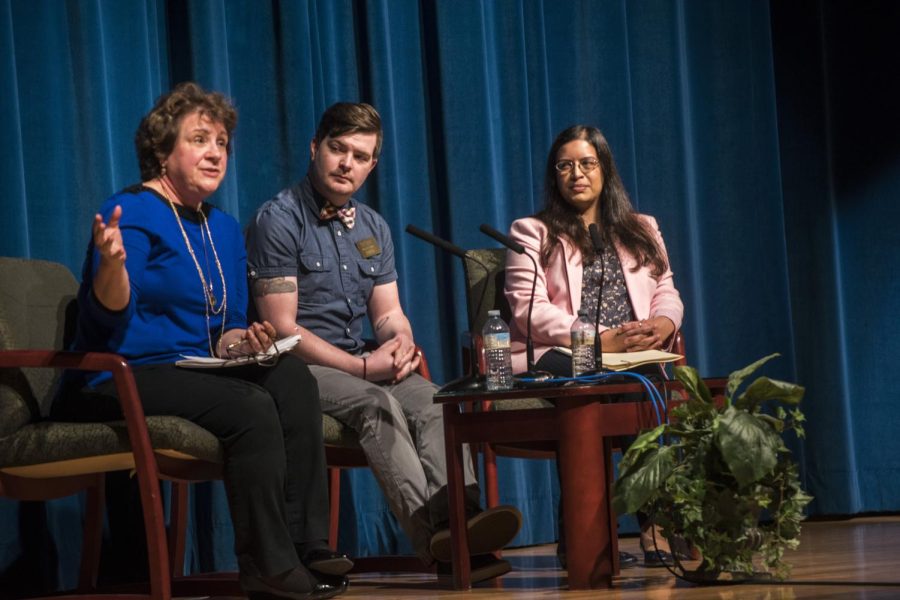Kent State faculty weighs in on ‘fake news’
Jan Leach, Journalism and Mass Communication associate professor; Michael Hawkins, resident librarian; and Rekha Sharma, Communications Studies assistant professor answer questions during the “Fighting Fake News” panel discussion in the KIVA on Monday, April 3, 2017.
April 3, 2017
Prevalence of fake news and the ongoing scrutiny of journalists and their credibility were the topics of discussion at the “Fighting Fake News” panel event in the KIVA on Monday.
“Fighting Fake News,” hosted by the College of Communication and Information (CCI), featured panelists Jan Leach, Journalism and Mass Communication associate professor and director of Kent State’s Media Law Center for Ethics and Access; Rekha Sharma, Communication Studies assistant professor; and Michael Hawkins, a resident librarian.
Different fake news occurrences like Pizzagate, a story on election ballots out of Columbus, Ohio, and the famous balloon boy story were discussed when analyzing public mistrust of the media. Sharma attributes this to the new age of social media and the internet.
“We are able to create and distribute a lot of conspiracy theories,” Sharma said. “It’s hard to make sense of what parts we’re able to believe and what parts are dubious.”
The line between conspiracy theories and fake news is often blurred, but Sharma thinks conspiracy theories often give the public a way to “explain traumatic events and help cope,” while fake news is “propagated for money and political purposes.”
Frank Scalambrino, Kent State philosophy professor, uses his profession to decipher what fake news is within the media, while also trying to define truth.
Scalambrino defines truth as “a property of a judgment.” However, he believes that there is not just one definition of truth.
“There are different kinds of truth,” Scalambrino said. “Semantic truth, metaphysical truth and epistemological truth.”
The semantic truth focuses on truth being a property of sentences, whereas according to the Merriam Webster dictionary, metaphysical truth is defined as “the truth of ultimate reality as partly or wholly transcendent of perceived actuality and experience.” Epistemological truth can be defined as analyzing the truth based on knowledge, belief, acceptance, verification and perspective.
Scalambrino said his definition of truth ties into how journalists should report on topics they have strong feelings toward.
“If you feel strongly about an issue, instead of attempting to manipulate the audience into seeing it as you see it, perhaps even against their will, you rather should tell the audience how you think they should see it and why they should see it that way,” Scalambrino said.
The perpetuation of fake news stories for political and monetary gains was a trend prominent in the last presidential election cycle. Scalambrino believes that there may be more incentive for behavior like this in the new age of digital media.
“We live in a sophisticated society,” Scalambrino said. “So there may be many people motivated to lie or spread falsehoods for whatever reason.”
Hawkins agreed that fake news often is deceptive, but consumers should be proactive about checking personal biases.
“Just because you agree with something, it doesn’t make it correct,” Hawkins said. “Evaluate the information (you are) receiving and the source where it’s coming from.”
As a journalist herself, Leach called on the media to stay as transparent as possible to regain trust from the public.
“We (the media) have to keep doing our jobs,” Leach said. “Media shouldn’t be defensive, we should do our jobs as accurately and consistently as possible.”
Molly Spillman is the CCI reporter, contact her at [email protected].
Lyric Aquino is the humanities reporter, contact her at [email protected].

























